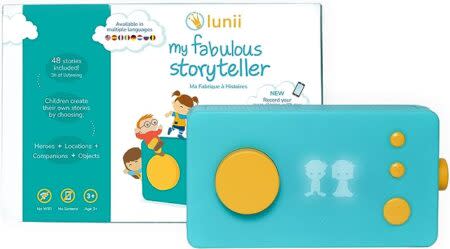Yes, you can teach your kid to like audiobooks
Audiobooks can be an amazing parenting tool. They’re screen-free, mess-free, inexpensive, and data shows they help foster reading comprehension in kids. But as much as I wanted them to be a part of my family’s life, I harbored some fears about how to go about introducing audiobooks to them: I worried that my kids would find them boring. That it was a “cheat” to have them listening to recordings of books instead of having me or my partner read to them. Did I mention I was worried they’d find them boring?
Because I was skeptical, I came up with a few ways I wanted to deliberately go about presenting audiobooks to my kids. To my pleasant surprise, the tactics I came up with worked, and they don’t just tolerate audiobooks—they like them. They ask for them! They’ve become an essential part of our parenting toolkit. I realized that enjoying audio content (not just books, but podcasts, too) is a skill, and it can be taught to our kids—we don’t have to just cross our fingers and hope for the best. So I consulted some experts, from a kid-lit advocate to a literacy researcher to other moms who’ve taught their own families to love audio content, and put together this guide to teaching your children to enjoy audiobooks, too.
6 tips on how to help your kids love audiobooks
1. Start small
Your child’s first exposure to an audiobook does not actually need to be an entire book. “When I talk about listening, I’m talking about not only audiobooks, but also podcasts… anything that has what we consider ‘rich language’,” says Tiffany P. Hogan, the director of the Speech and Language Literacy Lab at Massachusetts General Hospital and a research associate at Harvard University. This kind of content—that teaches, instructs, or uses higher-level vocabulary than your child typically hears in their day-to-day conversations—is hugely beneficial to them, Dr. Hogan explains.
You know your child best, so zero in on how long you think they could listen and focus on something— three minutes? Five minutes?—and look for a very short audiobook or podcast that fits. That’s how Kelly, the founder of Inclusive Storytime (Kelly does not use their last name in the media), introduced audio books in their own home. “I started with building stamina,” they say. “We went from really short audio books that were about five minutes, and very gradually worked our way up.”
2. Feature familiar characters
This was where I started with my own family, but it came up with everyone I spoke to: Take advantage of the fact that they know and love certain characters. Kelly started their child with Winnie-the-Pooh and Thomas the Tank Engine stories (free on Spotify!), which their child already loved. “Start with something they’re familiar with, and then it’s way more exciting,” they say. “Plus, when the visuals are already kind of implanted in their brain, you take away one of those barriers to entry. They’ve got the visual reference in their mind, so they can picture what’s happening.”
In my family, I turned to the beloved Princess in Black series as my gateway audiobook of choice. Paige Fowler, a mom of four and content creator @ourhomepaige, tells me: “I have a clear memory of driving to Whole Foods and putting on a Frog and Toad audio book from my phone using the Libby app. It had the sweetest music, and we had been reading those books at home. It totally captured my oldest’s attention. And I was like, wait, I’m onto something here.”
Another perk of using familiar stories? “As a parent who hadn’t listened to a ton of kids’ audio books, I knew what we were getting,” says Paige—there were no concerns about mature themes or outdated content. Or consider their interests: Dr. Hogan’s kids love sports, so she started them on “The Punies”, Kobe Bryant’s studio’s podcast. “The key is to make it enjoyable,” she says.
3. Take advantage of free resources
As you’re building your child’s interest in audio content, don’t feel like you have to spend a lot of money. There are tons of ways to do this without it becoming an expensive habit.
“Spotify has a fair number of children’s audiobooks, including some Disney ones, Thomas the Tank Engine, and other things that your kids will actually connect with,” says Kelly. This low-investment approach gives you more room to experiment as you’re figuring out what your kid(s) gravitate towards.
We use is the Libby app from our local library to borrow audiobooks, which we can play on Bluetooth speakers and in the car. Another lower-cost option is also Libro.fm, a streaming service with nearly 400,000 titles and a monthly fee of $15. If you go the podcast route, you can find them for free on Apple Podcasts or wherever you like to listen.
4. Give them control
While this is a little more expensive, another thing that came up consistently as having a huge effect is giving kids an audio player, such as a Yoto Player or the Toniebox (which is what we have). The devices go a mind-bogglingly long way towards making them excited to listen to stories. “[The Yoto] is one of the most powerful screen-free devices that I can think of,” says Kelly. “I think having that control is what helps to build a lot of the love.”
Paige agrees: “Having the player gives them the freedom to pick what they want to listen to, when they want to listen to it, and where they want to listen to it. As a parent, it’s less work on my end, and ultimately, they end up listening to more stories.”
Lindsay Livingston, RD, a mom of three and content creator @theleangreenbean, has found her kids’ Yoto players to be their favorite quiet-time toys. “I have found that giving one of my kids something to do with his hands and something to listen to really helps him calm his body down,” she says. Plus, “The player has allowed us to discover books that we might not have read normally,” says Kelly. It’s an investment, to be sure, but it goes a long way towards fostering enthusiasm around stories.
5. Use the stories to your advantage
Finding the right moment(s) in your day for audio content is another key part of maintaining their interest in listening. For us, my oldest gets to listen to an audiobook at night after her two siblings are in bed—a small treat that makes her feel like she’s getting to stay up late, and increases the excitement around it.
For Paige, the dreariness of longer car rides makes audiobooks something her whole family looks forward to. “There’s nothing else to do in there!” she says with a laugh.
Dr. Hogan encourages her kids to use audio content the same way she does—when she’s doing a task or chore she doesn’t really want to. “If my son says he’s bored with his chores, I’ll say, well, you know, when I’m bored, I listen to a podcast. And that makes it more fun!”
For Kelly’s family, audio content means peaceful mornings. “It’s part of our calming morning routine. My kid has the power to get up, get their own bowl of cereal, and start up the audiobook or a podcast on the Yoto player in the morning. And that is a way that I know that a routine is being followed that’s comforting, that is reliable, that is enriching and that is loved,” they say.
Perhaps most powerfully, Paige has seen her more introverted 4-year-old use her Yoto player to unwind after a big outing or long day. “It has become like her self-soothing technique of calming an overstimulated nervous system. And I’m like, that took me until my thirties to learn how to do! And she learned it at four, and can do it all on her own. It’s incredible.” It’s worth thinking about when during the day your child could most benefit from the routine, and slotting your stories in there.
You can also play around with the types of stories you use audiobooks for. Kelly has seen how listening to longer audiobooks has helped build their 7-year-old’s stamina for bigger chapter books and middle-grade fiction. Paige loves using audiobooks for chapter books that her kids adore but don’t hold her attention as well when she reads aloud, like the substantial Magic Tree House and Boxcar Children series. “This way I get to expose them to the books they love, and we can spend the time that I read to them reading books that I find more engaging.”
6. Let go of any guilt
Once your kids have gotten into listening to the audiobooks themselves, please do not fall into the trap I did of feeling bad about it—I briefly worried I had started using a technological hack that wasn’t “real reading.”
Luckily, I have seen the truth. “I study listening comprehension, and a lot of work shows that it’s the same brain circuitry whether you’re comprehending text or comprehending something spoken,” explains Dr. Hogan. “And a child’s ability to comprehend what they hear in an audiobook has its own merit outside of reading comprehension. Because it is related to children being able to follow complex directions, and understand the spoken language that they hear all around them,” she says.
Think of it this way: it’s not a replacement for us reading to them, it is an important complement that might turn out to serve your family in ways you never imagined.
“All kids learn in different ways,” says Lindsay. “You might be surprised to see that the audio version of different stories holds their attention even more than sitting and listening to a book.”
Looking to get started with audiobooks for kids? Check out our favorite audioplayers

Toniebox
• $99.95
Audio Player Starter Set
Not only does the Toniebox foster imagination without the distraction of flashy screens, but its intuitive design, featuring automatic playback with Tonies characters and easy volume and track controls, ensures your little one can enjoy bedtime stories, music, and educational content independently. Plus, the starter set comes with a playful Playtime Puppy Tonie, preloaded with 52 minutes of beloved children’s songs.

Yoto Player
• $119.99
Kids Bluetooth Audio Speaker
The Yoto Player not only brings stories to life with a fun pixel display but also serves as a bedtime storyteller with a nightlight, alarm and room thermometer. Setting up is a breeze: insert an audio card to play and your kiddo can dial in their preferences, or use the complementary Yoto App. With up to 24 hours of playback and a content library that grows with your child’s curiosity, it’s a smart, screen-free entertainment hub in and of itself.

Lunii
• $79.90
My Fabulous Storyteller
This portable, lightweight storyteller not only boosts imagination and vocabulary but lets children become the authors, selecting heroes, story settings, and more. With over 48 included stories, 300+ multilingual audiobooks available on Lunii.com, and the option to capture stories in the voices of loved ones via the Lunii app, it offers endless hours of screen-free creativity and joy in a very travel-friendly package.
